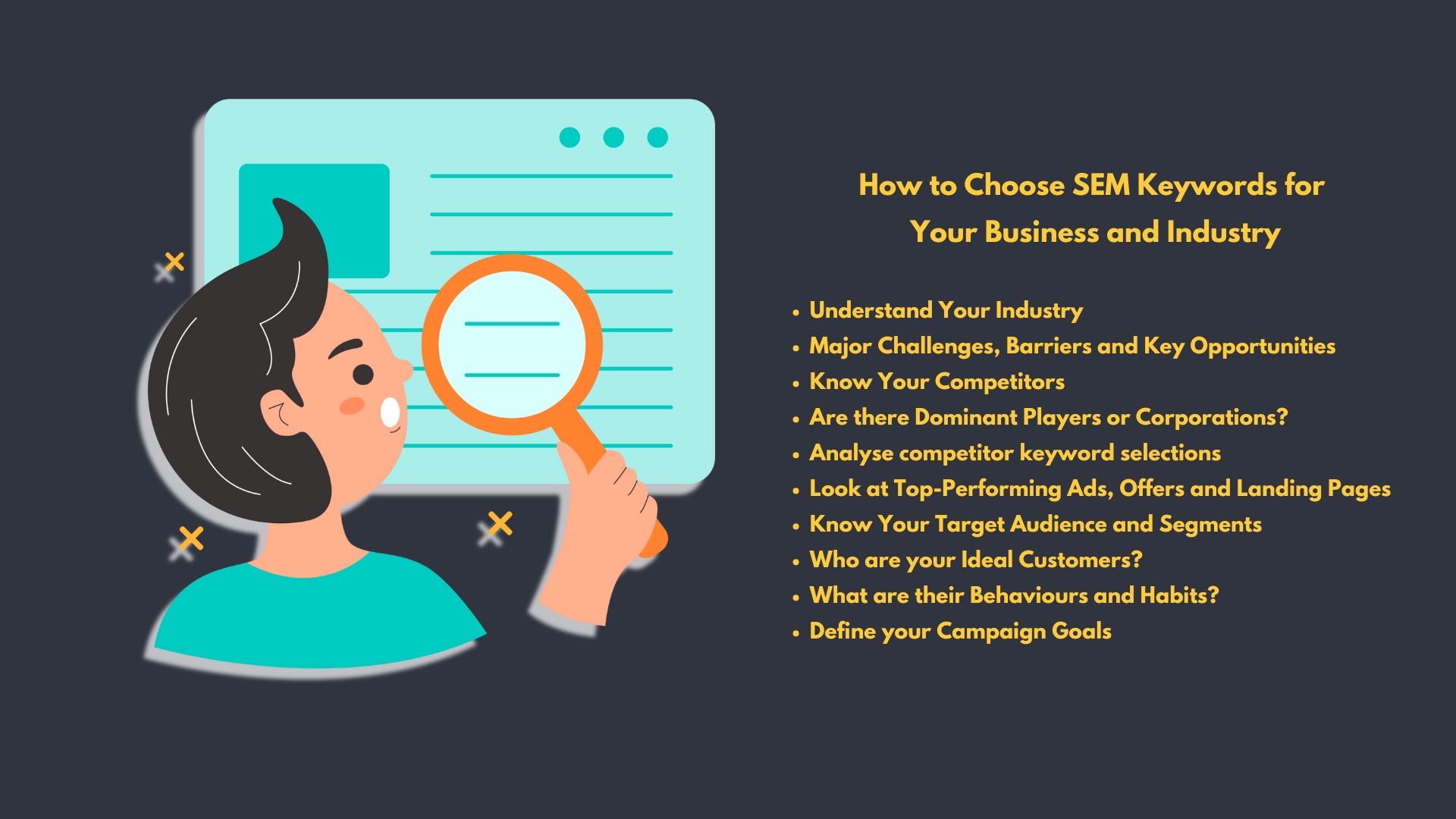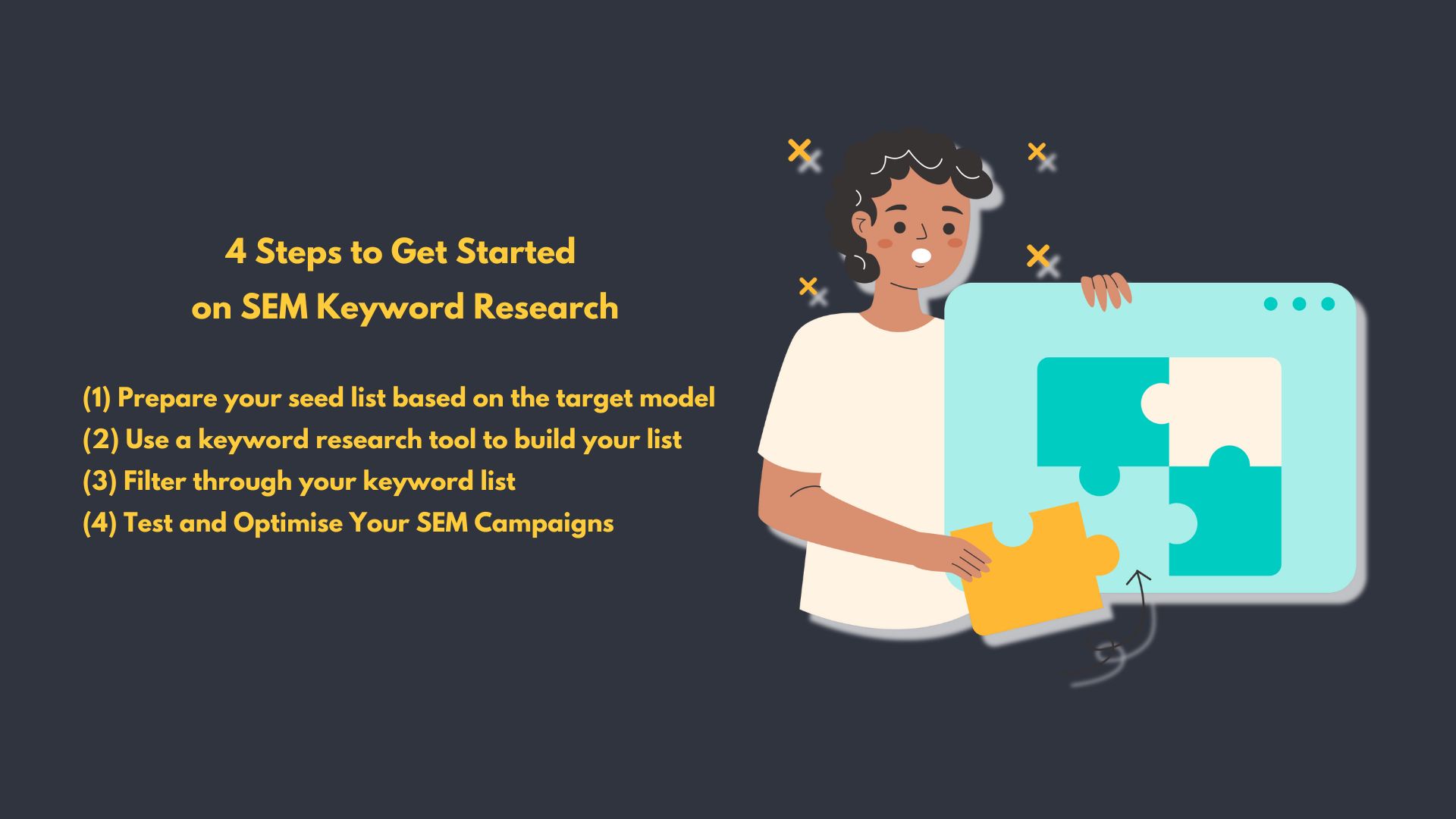Knowing which SEM keywords to target is the backbone of any business’ digital marketing campaign. Without knowing what types of keywords to target, you might be throwing money away and not even realising it.
In this quick in-depth guide, learn how to select keywords for SEM campaigns on Search Engines such as Google Search Engine.

What is Search Engine Marketing (SEM)?
Search Engine Marketing (SEM) leverages paid advertising to increase the visibility of your business’s products or services on search engine results pages (SERPs).
SEM technically refers to all types of search engine marketing, both organic and paid. However, it’s most commonly used to describe paid search marketing, where businesses bid on keywords to have their ads appear higher in search engine results.
When users enter specific keywords, SEM helps your business appear as one of the top results, ensuring greater exposure for relevant search queries and increasing the chances of click-through and conversion on your webpage or website.
What are SEM Keywords?
SEM keywords are words and phrases describing your product or service. These keywords are words that that you think your target customers will use to search for your product or service. They help determine when and where your ad will be displayed in search engine results.
In paid search, you’re paying Google to show your ads when someone enters a relevant keyword. Up to 4 PPC ads (pay-per-click) in a variation can be shown at the top of search results. These ads will appear above organic results.
Some keywords may convert better than others as they might show more purchase intent. Hence, there are vast differences in the cost-per-click (CPC) when choosing more highly competitive keywords. Optimising the campaign budget is key for the success of your campaign.
That’s why it’s up to businesses to decide on the right combination of keywords to drive online traffic and conversions for their business.
How to Choose SEM Keywords for Your Business and Industry

SEM keywords will determine who your ads will be shown to, and directly impact the chances of click-through and sales for your business.
- Understand Your Industry
- Major Challenges, Barriers and Key Opportunities
- Know Your Competitors – Are there Dominant Players or Corporations? Analyse their keyword selections
- Look at Top-Performing Ads, Offers and Landing Pages
- Know Your Target Audience and Segments
- Who are your Ideal Customers? What are their Behaviours and Habits?
- Define your Campaign Goals
Talk to Us about SEM Marketing and Advertising
How to do Keyword Research and Select the Right SEM Keywords
Here are some useful steps when you’re doing SEM keyword research and selection:
(1) Prepare your seed list based on the target model
A seed list is your initial keyword list. The target model in keyword research is a way of categorising keywords based on the level of interest or intent that they target.
The target model is useful for keyword research because it guides you to come up with that search terms that are relevant for those who are interested in products or services that are similar to yours.
The target model has various categories:
Brand terms
- Keywords in this category describe your brand. Those who are already familiar with your brand and search for your brand should be able to find you easily. Brand keywords can provide the best conversion rates for your business, although they might not necessarily give you the highest search or traffic volume.
Product terms
- Product keywords describe what your product is, what it does, or what problems it solves. They are used by those who are looking for solutions to their problem that your business could solve.
Competitor terms
- There are customers who make comparisons between you and your competitors. Make sure you know which are your top competitors and don’t leave competitor terms out during your keyword research.
Industry-specific terms
- Conduct thorough keyword research to identify common industry-specific keywords and key phrases. Ignoring this would be a missed opportunity for your campaign.
Substitute product terms
- Some people use words interchangeably. They might search for products that are similar to what you’re offering. For example, someone looking for “windbreaker” might also be searching for “jacket.” However, take note that these keywords may cost you more since Google’s algorithms do not consider them highly relevant for SEM.
Complementary product terms
- These keywords refer to related products or services that might go well with your own and are used by consumers. For example, if your business sells running shoes, a related product might be water bottles and gym accessories. You might want to consider bidding on these terms as well.
Audience terms
- Here, you could target any other word not covered in the other categories, but which your target audience might be searching for. This requires you to put yourself in your customer’s shoes and what words they would use.
Trending terms
- Check on search trends of your industry. What are some terms/questions/phrases that your customers or target users relate to and use? Check on seasonality that might temporarily impact search volumes.

(2) Use a keyword research tool to build your list
After you’re done with your seed list, you should expand it using Keyword Research Tools such as (Free and Paid options available):
- Google Adwords Keyword Planner – From Google
- Google Search Console (connected to your website)
- Google Search Engine (Google Suggest, Snippets, Related Searches, People Also Ask)
- Google Trends
- Semrush Keyword Tools
- Ahrefs Keyword Explorer
- Moz Keyword Explorer
- AnswerThePublic
- Keywords Everywhere
- WordStream Keyword Tool
- Backlinko Keyword Tool
- AI Chatbots and General Purpose Transformers (GPTs) like ChatGPT, Gemini, Perplexity AI, and more
Here are some tips to help you build your SEM keyword list:
Tip #1: Understand the Types of Keyword Search Intent
Search intent refers to the purpose behind a user’s search query. Understanding search intent helps businesses tailor their content and keywords to meet the needs of their target audience.
Businesses can then create targeted ad copy and landing page content that matches user expectations, improving their relevance and visibility on Google Search.
-
-
Informational Intent
– Goal: Users are seeking information or answers to specific questions.
– Examples: “What is digital marketing?”, “How does SEM work?”, “Best practices for email marketing”
– Content Focus: Blog posts, guides, tutorials, infographics, or articles that provide valuable and informative content. -
Navigational Intent
– Goal: Users want to find a specific website or webpage.
– Examples: “Facebook login”, “digital marketing agency”, “YouTube home”
– Content Focus: Ensure that the specific pages or brands users are searching for are easy to find, with clear navigation. -
Transactional Intent (Purchase Intent)
– Goal: Users are ready to make a purchase or take a specific action (e.g., sign up, download).
– Examples: “Buy 8K UHD TV”, “Order food delivery”, “Sign up for gym free trial”
– Content Focus: Product pages, services, pricing pages, call-to-action buttons, and landing pages optimised for conversions. -
Commercial Investigation (Commercial / Purchase Intent)
– Goal: Users are researching products or services before making a purchase decision.
– Examples: “Best software for video editing”, “A Item vs B Item”, “Top SEM tools”
– Content Focus: Product reviews, comparisons, testimonials, case studies, and product descriptions to help users in their decision-making process.
-
Tip #2: Choose both specific and general keywords
-
- You can use specific keywords to zoom in on customers who are interested in a particular product or service. With specific keywords, your ads will only show each time people search for business-specific terms. This means that people who are not looking to buy will not click on your ads since they don’t see it.
- This is essential to minimise frivolous ad spend. The downside with specific keywords is that you have limited audience reach, which is why some people prefer to mix your keyword list with general search terms.
- However, general keywords are broader in scope, so your ads may be shown even to those who are looking for something outside of what you’re offering. This may result in less qualified leads and a wasted ad spend.
Tip #3: Sort similar keywords into ad groups
-
- Doing this helps ensure that potential customers will see the most relevant ads. This is because you are grouping certain keywords together to target a particular product, service, or category.
- For example, you could create two ad groups if you’re selling watches. One ad group might have the search phrase “watches for men,” and the other one has “watches for women.” Customers would then see your ads when they’re trying to shop for watches that they can choose from based on their gender.
- Each of your ad groups should contain five to 20 keywords, so think of possible variations in terms and phrases that people are searching for.
Tip #4: Keyword Search Volume and Competition
-
-
If no one is searching for your target keywords, your ads will fail to deliver results. Do note that keywords with very high search volume often come with fierce competition and can sometimes be too generic.
-
The goal in keyword research is to find that sweet spot of relevant, high-volume, low-competition keywords—though they can be hard to find. Success comes from striking a balance between search demand (volume) and the available campaign budget to compete effectively.
- If this is your first time with SEM, begin with a modest budget and prioritise long-tail keywords (a keyword phrase that is generally made from three to five words). These tend to be less competitive while still highly relevant to your business.
- As you gather more data and experience, you can gradually increase your budget and start targeting more competitive keywords for better results.
-
(3) Filter through your keyword list
You will gain an advantage if you choose the best keywords for your SEM campaign – the ones that zero in on the intent of searchers.
You could refine your list through:
-
Keyword category
If you refer back to the target model in keyword research, you might notice that your audience keywords will have the greatest number of keywords compared with the rest of the categories. Refine your list by focusing on the higher-performing categories like brand terms and product terms.
As you’re paying for every click, you should always optimise your keyword selection to include the highest-converting keywords at the lowest possible CPC.
For underperforming keywords that might be costing you extra, you may want to eliminate them. This way, you’ll be lowering your customer acquisition cost (CAC) and maximizing the returns from your campaign.
-
Match type
Google lets you choose the kind of matching you want to use for your keywords in four different ways:
Use broad match:
If you want your ads to show up when someone searches using words that include any of your keywords. Anyone who searches for “bicycles” might come across your ad for “bicycle parts”.
Use phrase match:
If you want your ads to show up when someone types in a search phrase that matches your entire keyword phrase. Your ad for “bicycle repair and service” will be shown to those looking for “Tom’s bicycle repair and service.” Using “quotation marks” on your keywords means you’re aiming for a phrase match.
Use exact match:
If you want your keywords to be identical word for word to the search phrase. In this case, you need to put your keyword phrase in [square brackets].
Use negative match:
To exclude your ads from irrelevant searches by adding a minus sign before a keyword that are not related to your business. For example, you could add ‘-water bottles’ to indicate that your “bicycle repair and service” business does not sell water bottles. Many underestimate the power of negative keywords. One should spend equally, if not more time here to ensure the chosen keywords match user search intent and bring in the right traffic for your SEM campaign.
-
Audience Segmentation
Selecting SEM keywords involves segmenting your audience based on their needs and behaviors. Tools like Google Analytics, Facebook Audience Network, and SurveyMonkey can help gather and analyse data on your potential and existing customers.
Buyer / Customer Personas:
Creating buyer personas and mapping customer journeys provides insight into who they are, what they seek, and how they search. This allows you to tailor your keywords to align with their intent, preferences, and language. Modern marketing requires segmentation and personalisation: it is NOT a “one-size-fits-all” approach.
Effective SEM ad copy must directly address specific audience segments. You accomplish this by crafting ad copy that resonates with the unique needs, desires, and behaviors of each segment.
Crafting Ad Copy that Converts:
Use language and messaging that directly appeals to the specific motivations of your audience, whether they are looking for a solution, comparing products, or ready to make a purchase.
Personalising your SEM strategy ensures that your message feels more tailored, making your ads more effective and meaningful to each group.
By aligning your keywords and ad copy with the intent of your segmented audience, you can drive more relevant traffic and improve conversion rates.
(4) Test and Optimise Your SEM Campaigns

The final step in selecting SEM keywords is testing and optimisation. To drive continuous improvements, you should track and measure the performance of your keywords, ads, and campaigns using tools like Google Ads, Google Analytics, and Google Search Console.
Experimenting with A/B testing, keyword insertion, and dynamic keyword matching allows you to refine your keywords, bids, and landing pages. This approach helps boost your quality score, click-through rate, and conversion rate.
Successful SEM requires ongoing testing: it is NOT a “set it and forget it” strategy. Regular optimisation ensures you’re focusing on high-performing keywords that engage users and drive conversions, while also maximising your bidding strategy.
A search engine marketing agency or expert can assist in these areas if you are unsure how to do so, have a limited timeline and KPIs to hit.
Kickstart SEM Advertising for Your Business
Researching and selecting the right keywords form the foundation of your entire SEM strategy. Hence, to avoid wasting money on clicks, it’s integral that you understand which keywords work and which do not.
Your SEM strategy will likely evolve as your campaign progresses. They should consist of a mix of short and long-tail keywords to better target your customers.
Keep exploring your options – test your keywords, refine your lists, and create highly relevant variations. The more targeted and specific your keywords are, the better the quality of traffic you can expect from your search ads.
Talk to Us about SEM Marketing and Advertising
Related Posts
Achieve your business goals with qualified leads and sales through Digital Marketing

All
Articles
All Articles

Digital Marketing
Digital Marketing

Business Insights
Business Insights

TikTok Marketing
TikTok Marketing

Search Engine
Marketing (SEM)
Search Engine Marketing (SEM)

Search Engine
Optimization (SEO)
Search Engine Optimization (SEO)

Social
Media Marketing (SMM)
Social Media Marketing (SMM)
